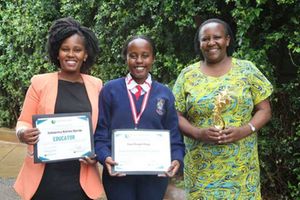
Amina Issa, the secretary to Abarrot Micro-Irrigation Scheme, harvests crops on the farm on November 9, 2024. The farm has solar-powered pumps.
On the banks of River Tana near Garissa town is the 400-acre Abarrot Micro Irrigation Scheme.
The farm, owned by a group of 30, introduced solar-powered irrigation in 2022 with help from the World Food Programme (WFP).
Every member has been allocated a portion of land to grow whatever crop he or she prefers.
“We started crop farming in 1988 when every household around was busy with livestock keeping and nomadism,” Shale Hillow, 88, the oldest member of the group, tells Seeds of Gold.
“Every member has a plot but the whole land is under Abarrot Scheme. We support one another.”
The group relied on diesel-powered generators to pump water from Kenya’s longest river to the farm until two years ago.
“The WFP approached us and helped install the solar system on the farm. I wish we knew about the system earlier,” the octogenarian says.
Since the installation of the system, the 30 farmers have enjoyed bumper harvest on the 100 acres under crop production.
Abarrot Micro Irrigation Scheme group secretary, Amina Issa, says the cost of production has fallen since the installation of the solar pump.
“Maintaining and running diesel engines was costly. It requires about 10 litres of diesel to irrigate an acre,” she says, adding that the generators are noisy and pollute the environment.
“The machine broke down frequently. We even lost two diesel engines to floods,” she says.
She says installing the solar system is costly. However, maintaining the system is manageable as it does not require fossil fuel.
“Our solar generator is commercially attractive and viable. Profits have gone up,” she says.
The solar generator has advanced cells that store power for long periods.
“We get around 300KW a day, with the extra power stored and used when there is little sunlight,” Issa says.

Amina Issa, the secretary to Abarrot Micro-Irrigation Scheme, harvests crops on the farm on November 9, 2024. The farm has solar-powered pumps.
Said Mohamed, a technician at Davis and Shirtliff, says surface solar pumps are good for irrigating large parcels of land.
“A DHS300 one pumps more than 90,000 litres of water a day,” he says.
The surface pump needs about six solar panels of 350W each.
Mohamed says laying the irrigation pipes properly reduces water wastage, leading to low maintenance costs for the solar-powered generator.
“To improve the lifespan of the coil, the store should not be damp. The panels must be dust-free always,” Mohamed says.
Installing a solar irrigation system is expensive because of the piping involved. However, the farmers have access to credit.
“A farmer or group can acquire a solar-powered generator and pay on a monthly basis,” he says.
One can get the generator after depositing Sh24,300. The monthly payment runs for two years.
“I joined the group after being encouraged by a friend. My cows, goats, sheep and camels used to die during droughts. Crop farming was more promising,” says Ahmed Burale, a member of the group.
However, floods destroyed an estimated 10 tonnes of crops in May.
“We lost 30 acres of bananas to floods. It was devastating but we never gave up,” he says.
The piping system and roads at the farm were damaged but the solar panels remained intact as they were on a raised stand.
“The stands holding the panels are more than two metres above the ground. The panels are properly anchored,” Mohamed says.
Habiba Abdullahi, another member, says she pays her children’s school fees from the farm proceeds.
“I grow fruits, vegetables and pasture,” she says.
As the Seeds of Gold team toured the farm, group members were preparing land for planting.
“We are in the process of restoring our banana plantation,” Issa says.
The farmers grow mangoes, citrus fruits, watermelon, vegetables and pasture.
The other crops are okra, sweat melon, pixies, spinach and beans.
“A tractor is preparing the land for planting. We have worked on the damaged irrigation pipes and are ready to start afresh. Giving up is not in our vocabulary,” Issa says.








